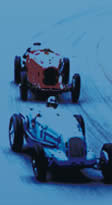Le Mans Classic 2006
Although not the 24 hrs, the Le Mans Classic has far more interesting cars and a very similar atmosphere plus a gratifyingly large crowd, the stands being still almost full at midnight. I (Kirk Rylands) was acting as ‘gofor’ for Team Pilkington. Richard was running his 1937 4½ litre Talbot in sports car mode in which form it ran in two Le Mans and came 5th in the Mille Miglia. Without wings, it ran in numerous GPs finishing 4th in the French GP at Reims behind three Mercedes, so pretty brisk. The event is divided into 6 age groups ranging from 1923 to 1979 and each group has three races, two in daylight and one at night.
After a very civilised night with Flavien and Vanessa Marcais at their not inconsiderable pile near Evreux, we arrived at the circuit on Thursday lunchtime and set about the paperwork and scrutineering. I considered buying a ticket to the ‘Driver’s Club’ but when told it was £280 had a rethink. Scrutineering was a real box ticking exercise and one of the boxes was cut out switches which needed a little attention but obviously lights were not included as Richard later found himself pounding down Mulsanne at about 130 mph and coming across some plonker in a pedal car doing about 50 with no lights on at all – scary. Most of the cars were splendid but there were a few in the pre war grid that may have been exactly like some sewing machine engined contraption that chugged round in 1923 but were so slow that they can’t have been any fun to drive and really brought little to the party. Whilst commenting on scrutineering, after the race we noticed a Gordini coupe with original Englebert tyres on it that must have been 60 years old and not really the thing for Le Mans in our view.
Richard was fastest in both his day and night practice sessions and also won all three of the pre war races though there were some English Talbots not that far behind at one stage.
After the first race, he was penalised 30 seconds for being 3 seconds short of the requisite 1½ minutes in the pits. This was surprising as he had a stop watch on the dash. It then transpired that many others had been similarly penalised so Richard and Flavien went off to the powers that be and did a bit of pushing and shoving all to no avail until Richard noticed that the time keepers were using the wrong line in the pit lane – and these guys do the 24 hrs. In a similar vein, Philip Walker won his three races in his Lotus 15 in the ’57 to ’61 age group but was classified second in one race being beaten by 3 seconds by someone who used a loop-hole widely known about from the last event and that was driving straight through the pits without stopping which only incurred a 30 second penalty, but saved rather more than spending the 1½ minutes required between entering and leaving the pit lane. We couldn’t believe it was still possible and like I said, these guys run the 24 hrs. One more aspect that needs sorting out was the rolling start. Strictly no overtaking on the formation lap but some dim wits didn’t seem to appreciate that they are meant to keep up and just dawdled round which must have been infuriating for any proper racer stuck behind them, after perhaps a problem in practice, as they ended up starting the race about 3 miles behind the leader.
With about 400 cars and at least twice as many drivers, the scope for a king sized cock-up was certainly there but apart from minor irritations, the event ran very well. It seemed as though most of the security staff had been recruited from an establishment catering for the educationally sub normal and still hadn’t forgiven us for Crecy but they were more than made up for by the splendid people running WW2 Jeeps with trailers as a taxi service between the motorhome area and the paddock. They had their own WW2 tented camp and were just as much old car enthusiasts as we are – just a different sort and they really added to the event.
Richard’s three races were at 4 pm on the Saturday, then again at about half past midnight and finally at 8.15 on the Sunday morning when it rained - not a lot and not enough to do any good but enough to lubricate all the oil and rubber so that he reckoned he was getting wheelspin in top on the straight. Not nice. The Talbot went brilliantly but got a little overheated so we removed the radiator grille and the side of the bonnet. A carburettor trumpet went missing but another was soon fashioned out of a coke tin. We shared a paddock space with a most efficient crew running a Morgan who kept us supplied with tea and coffee and were most agreeable neighbours.
Leaning on the pit wall in the middle of the night is exciting, watching the Porsches howling by with their turbos glowing red hot in the dark and the sheet of flame that comes out as they lift off for the chicane by the Dunlop Bridge. If that doesn’t strike a chord then I reckon you are wired up wrong. There were stacks of iconic cars doing what they were really built for from the 1928 Mercedes SS making that unmistakeable supercharger scream to C and D types, all sorts of Ferraris, Astons, GT40s, Lola T70s, Matras and so on. There was something for everyone on the circuit plus the extensive stands selling the normal range of tat but also some very classy stuff as well and the chance to spend real money at the Christie’s Auction. If you still had any spare energy, there were thousands of cars in club displays of every kind.
Then suddenly it’s all over. We wandered back to the camper from the lengthy prize giving and sat outside having a quiet drink and watching a dirty fly spattered oil stained 917 Porsche trundling down the dusty track to load up and thought ‘that’s what it’s all about’. A huge appreciative crowd that probably consisted of more genuine enthusiasts that those at the 24 hrs. Yes, I’d go again.
Photos by Eric Sawyer, Richard Hampson, Trisha Pilkington. All copyright.
J.K.R.
|


